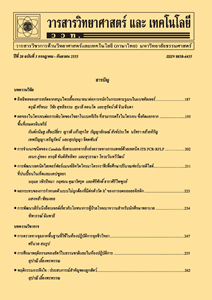ผลกระทบจากโครงการรถยนต์ใหม่คันแรกตามนโยบายรัฐบาลต่อปริมาณจราจรและความเร็วในการเดินทางด้วยรถยนต์ในเขตกรุงเทพมหานคร
Main Article Content
Abstract
บทคัดย่อ
หลังจากที่รัฐบาลไทยดำเนินโครงการรถยนต์ใหม่คันแรก ตั้งแต่ 16 กันยายน 2554 ถึง 31 ธันวาคม 2555 ซึ่งมีผู้ใช้สิทธิ์เป็นจำนวนมาก จึงมีบุคคล กลุ่มบุคคล และหน่วยงานหลายฝ่าย ได้แสดงทัศนคติต่อการดำเนินโครงการผ่านสื่อสิ่งพิมพ์ สื่อออนไลน์ และเครือข่ายสังคมออนไลน์ ทั้งสนับสนุน โต้แย้ง อธิบายผลดี ผลเสีย เป็นปรากฏการณ์ทางกระแสสังคมที่ค่อนข้างรุนแรง โดยเฉพาะประเด็นที่แสดงถึงข้อขัดแย้งเชิงนโยบายของรัฐบาลเอง ที่ต้องการแก้ปัญหาจราจรอย่างเป็นรูปธรรม แต่ส่งเสริมให้ประชาชนซื้อรถยนต์ส่วนบุคคลเพิ่มขึ้น ซึ่งเท่ากับช้ำเติมปัญหาจราจรให้มีความรุนแรงมากยิ่งขึ้น จึงเกิดกระแสต่อต้านจากประชาชนบางส่วน ดังนั้นการวิเคราะห์ผลกระทบจากจำนวนรถยนต์ที่เพิ่มขึ้นจากการดำเนินโครงการรถยนต์ใหม่คันแรกต่อปริมาณจราจร และความเร็วในการเดินทางด้วยรถยนต์ส่วนบุคคลในเขตกรุงเทพมหานคร โดยใช้เทคนิคการพยากรณ์ด้วยอนุกรมเวลา และการวิเคราะห์ความถดถอยแบบพหุคูณ จะเป็นเครื่องมือบ่งชี้ผลกระทบด้านการจราจรจากโครงการดังกล่าว และเป็นข้อพิจารณาในการกำหนดนโยบายการบริหารประเทศของรัฐบาล โดยเฉพาะอย่างยิ่งนโยบายที่เกี่ยวข้องกับการเปลี่ยนแปลงภาษีรถยนต์ ผลการเปรียบเทียบค่าสถิติในปี พ.ศ. 2556 กับค่าจากการพยากรณ์ที่สันนิษฐานว่าไม่มีโครงการ พบว่า จำนวนรถยนต์สะสมทั่วประเทศ เพิ่มขึ้น 12.94 % ปริมาณการจราจรบนทางหลวงในเขตกรุงเทพมหานคร เพิ่มขึ้น 8.22 % ส่วนความเร็วในการเดินทางในช่วงเร่งด่วนเช้าและช่วงเร่งด่วนเย็นลดลง 3.26 และ 5.76 % ตามลำดับ
คำสำคัญ : โครงการรถยนต์ใหม่คันแรก; นโยบายรัฐบาล; จำนวนรถยนต์; ปริมาณการจราจร; ความเร็วในการเดินทาง
Abstract
After the Thai Government implemented their project under the First Car Policy during 19 September 2013 - 31 December 2014, with many eligible persons, many individuals and groups of individuals as well as organizations and agencies have expressed their views about the project through various media. Opinions, both positive and negative, were voiced through printed publications, online media and online network. Some come in form of debates with the benefits and disadvantages of the project. It was one of the most intensely discussed social trend phenomena, especially because it shows that the government’s policies were conflicting within itself. On one hand, the government would like to have a tangible solution to the ongoing traffic problem, while on the other hand they are supporting and enhancing the capacity for people to own more private cars. This policy then became the top up to the traffic problem, making it more severe and therefore some people opposed to the idea. Thus, this study intended to analyze the impacts from the increased numbers of new vehicles on the road on the traffic condition and travel speed in Bangkok. The Time Series Forecasting and Multiple Regression analysis techniques are used to identify the impacts of the project and which will be used in making considerations about the government’s decision to set up administrative policies. This is most directly related to the policies regarding the change in taxation values for vehicles. The 2013 statistics were compared with the predicted values for the scenario of no First Car Policy and results showed that the number of vehicle registered in Thailand would increase by 12.5 % and traffic volume would increase by 8.22 % on the highways in Bangkok. On the issue of travel speed, it was indicated that the peak-hour speed will decrease by 3.26 and 5.76 % respectively for AM and PM peak hours.
Keywords: first car policy; government policy; number of vehicles; traffic volume; travel speed


